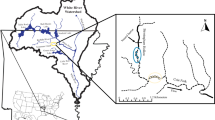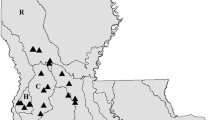Abstract
Quantitative data on the habitat characteristics of stream crayfish have been generally lacking and competing demands on water resources has created a need to address this knowledge gap. We investigated day-time habitat relationships of stream crayfish (Paranephrops planifrons White) from 793 quadrats at 30 rivers and streams in the North Island, New Zealand to develop models of koura presence–absence and abundance. The model (stepwise GAM) included width, cover, median substrate size, edge location, velocity and depth, and correctly predicted presence–absence of crayfish (8–39 mm OCL) at 73.4% of quadrats and of young-of-the-year (YOY) ≤8 mm OCL at 83.4% of quadrats. Streams ranged from 1.6 to 11.5 m in width and the probability of finding both crayfish size classes reduced sharply as streams became wider than 6 m and as the substrate became large (i.e., boulder > 256 mm). Crayfish, particularly YOY, were most likely to be found in association with cover and at the stream edge. YOY were associated with shallow depths and fine substrates, whereas larger crayfish showed a preference for cobble substrate. Undercut banks, leaf litter, tree roots, and woody debris were strongly related to the presence–absence of crayfish. The model for crayfish abundance (log-linear Poisson GAM) explained 50% of the variation between quadrats with cover, velocity, edge location, depth, and the overall crayfish abundance at each particular stream being significant variables. Highest crayfish numbers were recorded in still or slow flowing water, with the majority occurring where velocities were below 0.4 m/s. Water depths up to 0.7 m were sampled, but highest numbers were found in depths of 0.2–0.3 m. Our presence–absence model determined variables that were significant over all streams, whereas our abundance model determined variables that were significant within streams. Use of the GAMs models enabled us to untangle the multiple factors contributing to habitat selection. Cover, velocity, and locations at the stream edge were important determinants of both presence–absence and abundance. Generally, substrate was important when comparing between streams, but not within streams, whereas depth was a significant determinant of abundance within streams, but not presence–absence between streams.






Similar content being viewed by others
References
Alberstadt, P. J., C. W. Steele & C. Skinner, 1996. Cover-seeking behaviour in juvenile and adult crayfish, Orconectes rusticus: effects of darkness and thigmotactic cues. Journal of Crustacean Biology 15: 537–541.
Aquiloni, L., M. Ilhéu & F. Gherardi, 2005. Habitat use and dispersal of the invasive crayfish Procambarus clarkii in ephemeral water bodies of Portugal. Marine and Freshwater Behaviour and Physiology 38: 225–236.
Austin, M. P., 2002. Spatial prediction of species distribution: an interface between ecological theory and statistical modelling. Ecological Modelling 157: 101–118.
Boyce, M. S., P. R. Vernier, S. E. Nielsen & F. K. A. Schmiegelow, 2002. Evaluating resource selection functions. Ecological Modelling 157: 281–300.
Castleberry, D.T., J. J. Cech, D. C. Erman, D. Hankin, M. Healey, G. M. Kondolf, M. Mangel, M. Mohr, P. Moyle, J. Nielsen, T. P. Speed & J. G. Williams, 1996. Uncertainty and instream flow standards. Fisheries 21: 20–21.
Chow, V. T., 1959. Open channel hydraulics. McGraw-Hill, Kogakusha, Japan.
Cohen, J., 1960. A coefficient of agreement for nominal scales. Educational and Psychological Measurement. 20: 37–46.
Eversole, A. G. & J. W. Foltz, 1993. Habitat relationships of two crayfish species in a mountain stream. Freshwater Crayfish 9: 300–310.
Englund, G. & J. J. Krupa, 2000. Habitat use by crayfish in stream pools: influence of predators, depth and body size. Freshwater Biology 43: 75–83.
Gore, J. A. & R. M. Bryant, 1990. Temporal shifts in physical habitat of the crayfish, Orconectes neglectus (Faxon). Hydrobiologia 199: 131–142.
Guisan, A., T. C. Edwards & T. J. Hastie, 2002. Generalized linear and generalized additive models in studies of species distributions: setting the scene. Ecological Modelling 157: 89–100.
Hastie, T. J. & R. J. Tibshirani, 1990. Generalized additive models. Monographs on Statistics and Applied Probability 43. Chapman and Hall, 1st edition, New York.
Jowett, I. G. & J. Richardson, 1990. Microhabitat preferences of benthic invertebrates in a New Zealand river and the development of in-stream flow-habitat models for Deleatidium spp. New Zealand Journal of Marine and Freshwater Research 24: 19–30.
Kerby, J. L., S. P. Riley, L. B. Kats & P. Wilson, 2005. Barriers and flow as limiting factors in the spread of an invasive crayfish (Procambarus clarkii) in southern California streams. Biological Conservation 126: 402–409.
Kondolf, G. G., E. W. Larsen & J. G. Williams, 2000. Measuring and modelling the hydraulic environment for assessing instream flows. North American Journal of Fisheries Management 20: 1016–1028.
Kutka, F. J., C. Richards & G. W. Merrick, 1996. Habitat relationships and distribution of the crayfish, Orconectes propinquus, in the Saint Louis River Basin, Minnesota, USA. Freshwater Crayfish 11: 72–82.
Leathwick, J. R. & M. P. Austin, 2001. Competitive interactions between tree species in New Zealand’s old-growth indigenous forests. Ecology 82: 2560–2573.
Leathwick, J. R. & G. M. Rogers, 1996. Modelling relationships between environment and canopy composition in secondary vegetation in central North Island, New Zealand. New Zealand. Journal of Ecology 20: 147–161.
Mathur, D., W. H. Bason, E. J. Purdy & C. A. Silver, 1985. A critique of the instream flow incremental methodology. Canadian Journal of Fisheries and Aquatic Sciences 42: 825–831.
Maude, S. H. & D. D. Williams, 1983. Behaviour of crayfish in water currents: hydrodynamics of eight species with reference to their distribution patterns in Southern Ontario. Canadian Journal of Fisheries and Aquatic Science 40: 68–77.
Nakata, K., T. Hamano, K. Hayashi & T. Kawai, 2003. Water velocity in artificial habitats of the Japanese crayfish Cambaroides japonicus. Fisheries Science 69: 343–347.
Nelder, J. A. & R. W. M. Wedderburn, 1972. Generalized linear models. Journal of the Royal Statistical Society, Series A. 135: 370–384.
Parkyn, S. M., K. J. Collier & B. J. Hicks, 2002. Growth and population dynamics of crayfish Paranephrops planifrons in streams within native forest and pastoral land uses. New Zealand Journal of Marine and Freshwater Research 36: 847–861.
Parkyn, S. M. & K. J. Collier, 2004. Interaction of press and pulse disturbances on crayfish populations: flood impacts in pasture and forest streams. Hydrobiologia 527: 113–124.
Rabeni, C. F., 1985. Resource partitioning by stream-dwelling crayfish: the influence of body size. American Midland Naturalist 113: 20–29.
Rabeni, C. F., K. J. Collier, S. M. Parkyn & B. J. Hicks, 1997. Evaluating methods of sampling stream crayfish. New Zealand Journal of Marine and Freshwater Research 31: 693–700.
Riordan, P., 2000. Population dynamics, habitat analysis, and food assimilation in the freshwater crayfish Paranephrops planifrons in a North Island stream. Unpubl. MSc Thesis, University of Waikato.
Scott, D. & C. S. Shirvell, 1987. A critique of the instream flow incremental methodology and observations on flow determination in New Zealand. In Kemper, J. B. & J. Craig (eds), Regulated streams – advances in ecology. Plenum Press, New York: 27–44.
Stalnaker, C.B., L. Lamb, J. Henriksen, K. Bovee & J. Bartholow, 1995. The instream flow incremental methodology: a primer for IFIM. National Biological Service, Fort Collins, Biological Report 29.
Statzner, B., J. A. Gore & V. H. Resh, 1988. Hydraulic stream ecology: observed patterns and potential applications. Journal of the North American Benthological Society 7: 307–360.
Usio, N. & C. R. Townsend, 2000. Distribution of the New Zealand crayfish Paranephrops zealandicus in relation to stream physico-chemistry, predatory fish, and invertebrate prey. New Zealand Journal of Marine and Freshwater Research 34: 557–567.
Usio, N., H. Nakajima, R. Kamiyama, I. Wakana, S. Hiruta & N. Takamura, 2006. Predicting the distribution of invasive crayfish (Pacifastacus leniusculus) in a Kusiro Moor marsh (Japan) using classification and regression trees. Ecological Research 21: 271–277.
Wolman, M.G., 1954. A method of sampling coarse river-bed material. Transactions of the American Geophysical Union 35: 951–956.
Author information
Authors and Affiliations
Corresponding author
Additional information
Handling editor: K. Martens
Rights and permissions
About this article
Cite this article
Jowett, I.G., Parkyn, S.M. & Richardson, J. Habitat characteristics of crayfish (Paranephrops planifrons) in New Zealand streams using generalised additive models (GAMs). Hydrobiologia 596, 353–365 (2008). https://doi.org/10.1007/s10750-007-9108-z
Received:
Revised:
Accepted:
Published:
Issue Date:
DOI: https://doi.org/10.1007/s10750-007-9108-z




